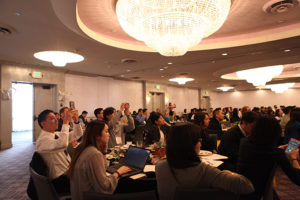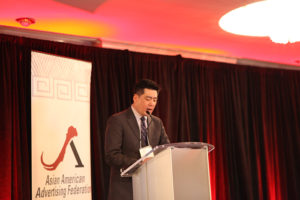
By Mandy Day
AsAmNews Staff Writer
The Asian American Advertising Federation (3AF) kicks off its 2016 Asian Marketing Summit in Los Angeles’ Koreatown today. Featuring speakers from some of the country’s most influential corporations and organizations, the summit will also shed light on trends in the Asian American market and the buying power of the burgeoning U.S. population.
“The Summit starts with what we call the Boot Camp, which grounds attendees in critical basics including Asian demographics and psychographics, research tools, Asian media landscape and a relevant case study,” said 3AF President Edward Chang told AsAmNews.
According to Mark Hugo Lopez, Director of Hispanic Research at the Pew Research Center, by 2065 the United States will have a population of more than 440 million people. Without current immigration trends between 2015 and 2065, that number plummets by more than 100 million. Immigrant populations and their descendants are having a tremendous impact on the U.S. economy, and corporations have noticed. According to an article by the Pew Charitable Trusts, immigrants historically originated in Mexico, but since the recession and better economic opportunities in Mexico, immigration from the South has steeply declined. Ever since, the majority of new immigration is coming from Asia, specifically India and China.
Many Asian immigrants come to study and are offered employment in the U.S. after graduation, according to the Migration Policy Institute. Tens of thousands are eligible for several different types of work visas designated for skilled workers. These immigrants lack familial ties to the country and can become primary sponsors for bringing family members from their native countries to the United States, should they be granted permanent residency and choose to stay. Due to the high demand for such labor, these immigrants earn higher wages and thus become a population of potential consumers of luxury goods. Their hire wages and buying power make them a desirable target for advertisers.
Past campaigns by major corporations have been specifically designed for Asian immigrants and Asian Americans through Asian television stations and print ads in targeted communities. Chang was elected to serve as President of 3AF in 2013 and also serves as a Vice President and Group Account Director at APartnership based in New York City. He discussed the past year’s activities for 3AF’s membership.
“Our members have partnered with federal, state and local government and non-profits to connect Asian Americans to public health and community services. Many of these communications are executed in Asian languages and appear in Asian media which remain a critical information backbone to our largely immigrant populations. All communications take advantage of the easily accessible media channels from television, radio, print, experiential, and out-of-home advertising.”
According to a survey conducted by the Bureau of Labor Statistics in 2012, Asian American households spend, on average, 19% more on products and services than the overall number of households surveyed. It’s expected that buying power among Asian Americans will increase 32% by 2020 from 2015 figures. Asian Americans are also the highest median income households in the United States compared to other ethnic groups. The additional disposable income in Asian American households allow for consumers to purchase additional services and consumer products.

Mr. Chang and I discussed how the rising influence of Asian Americans as consumers influence the way major corporations diversify their advertising for mass marketing to consumers. He mentioned that while advertisers continue to increase ethnic representation in their national campaigns, marketing specifically to certain ethnic groups remains an integral part of their push to gain new customers and retain existing ones.
“Advertising is most effective when it resonates with a consumer group. It needs to connect with the sensibilities, experiences and emotions of the group. It also depends on the service or product itself, and its affiliations to an audience. So, while I think the representation of Asians in general nationwide advertising can be positive, it may not be the most meaningful or effective or way to communicate with segments of Asian consumers, representing different experiences specifically.”
In past weeks, Asian American celebrities such as Aziz Ansari and Constance Wu have been outspoken advocates for fair representation in entertainment. With so many stereotypes about Asians permeating mass media, from the “terrorist/cab driver” Middle Eastern typecast to the “submissive sexual object/tiger mom” for East Asian actresses, I wondered if corporate interests in marketing perpetuated the stereotypes and contributed to a lack of representation in other aspects of media. As an industry expert, I asked Mr. Chang if much of this consumer outreach in Asian American communities was to placate customers rather than contribute to a changing mindset for ethnic minorities. He answered:
“I think for corporations ultimately it is about meeting their growth and profitability mandates. So, I see it as 3AF’s charge to help marketers understand the Asian consumer opportunity and how it can support those mandates beyond simple notions of community goodwill. But I want the Asian community to also understand that we recognize how important our authentic representation is in mass media. I have often said that media is ultimately driven by advertising and marketing dollars. If Asians as a consumer group are not important to marketers, then we will lack media visibility, and without media visibility negative stereotypes will persist and we do not influence the social dialogue. I don’t believe placating will be to anyone’s advantage. Rather, having meaningful and sustained capital investment that supports mutual end goals will be indispensible.”
We then discussed how having Asian Americans in decision-making positions can affect positive change in how corporations market to marginalized communities. 3AF has hosted numerous speakers like author and executive coach Jane Hyun, and Gerald Johnson, Chief Diversity Officer at the American Heart Association, who have incorporated diversity mandates into commonsense marketing strategies. Chang said, “We seek out expert voices such as theirs for partnership, and to help 3AF and the marketing community as a whole break through these issues with a return on investment mindset”.
This year’s speakers include: DramaFever co-founder and CEO, Suk Park; Ankit Brahmkshatri the manager of supplier diversity at The Walt Disney Company; Sharmila Fowler, McDonald’s Director of Asian Marketing; actor Kelvin Yu and television producer Melvin Mar; and representatives from BMW, Google, Toyota, AARP, and Nielsen. The packed schedule discussing topics from Asians in the entertainment industry to Asian consumers in the luxury goods market, and the impact of Asian immigration on the U.S. economy.
Established more than a decade ago, the Asian Marketing Summit seeks to create partnerships between its attendees in order to promote further outreach into the growing number of Asian American communities in the United States. “Our members include advertising agencies, research houses, content creators, media companies, corporate marketers and individual students whose work, staffing and interests represent the diverse Asian diaspora,” Chang said.
The summit, hosted at The Line Hotel, a two and-a-half year old newcomer in the heart of Koreatown, will bring together 175 attendees to listen to presentations given by representatives from a variety of companies and research organizations.
The Asian American Advertising Federation’s marketing summit and bootcamp run from Jun 1st through June 3rd. For more information on the organization and the event, click here.

